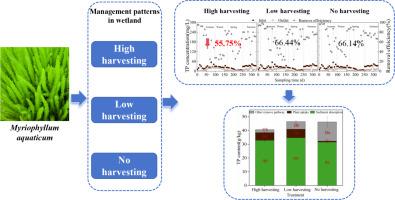Does high-frequency plant harvesting improve phosphorus removal efficiency in constructed wetlands?
IF 4.1
2区 环境科学与生态学
Q1 ECOLOGY
引用次数: 0
Abstract
Plant harvesting is recognized as an effective measure for enhancing phosphorus removal in constructed wetlands; however, excessive plant harvesting can compromise phosphorus removal efficiency. How to optimize plant management strategies, such as adjusting harvesting frequency, to sustain the long-term phosphorus removal efficiency of wetlands remains worth exploring. In this study, Myriophyllum aquaticum was used as the wetland plant, and a one-year experiment was conducted with three treatments: high-frequency harvesting (once every 45 days), low-frequency harvesting (once every 90 days), and no harvesting (control). The results showed no significant difference in the annual average total phosphorus (TP) removal efficiency between the low-frequency harvesting treatment (66.44 %) and the control (66.14 %), while the TP removal efficiency in the high-frequency harvesting treatment was only 55.75 %. Although high-frequency harvesting reduced phosphorus removal efficiency, it obviously increased plant phosphorus uptake. The amount of phosphorus removed through the high-frequency and the low-frequency harvesting treatments was 8.21 and 8.82 times higher, respectively, than that in the no harvesting treatment. In addition, plant harvesting can enhance the sediment's phosphorus adsorption capacity, particularly for iron-bound phosphorus and aluminum-bound phosphorus. These findings indicate that while plant harvesting enhances plant phosphorus uptake and sediment phosphorus adsorption capacity, excessive harvesting reduces overall phosphorus removal efficiency in wetlands. Therefore, selecting an appropriate harvesting frequency is of great significance for the long-term operation of constructed wetlands.

高频率的植物收获是否能提高人工湿地的除磷效率?
植物收获是提高人工湿地除磷效果的有效措施;然而,过量的植物收获会影响除磷效率。如何优化植物管理策略,如调整收获频率,以维持湿地的长期除磷效率仍然值得探索。本研究以水生肉豆蔻(Myriophyllum aquaticum)为湿地植物,进行为期一年的试验,分高频采收(45 d 1次)、低频采收(90 d 1次)和不采收(对照)3个处理。结果表明,低频收获处理的年平均总磷去除率(66.44%)与对照组(66.14%)无显著差异,而高频收获处理的TP去除率仅为55.75%。高频收获虽然降低了磷的去除效率,但明显提高了植物对磷的吸收量。高频和低频收获处理的磷去除率分别是不收获处理的8.21倍和8.82倍。此外,植物收获可以增强沉积物对磷的吸附能力,特别是对铁结合磷和铝结合磷的吸附能力。这些结果表明,虽然植物收获提高了植物对磷的吸收和沉积物对磷的吸附能力,但过度收获会降低湿地的总体除磷效率。因此,选择合适的收获频率对人工湿地的长期运行具有重要意义。
本文章由计算机程序翻译,如有差异,请以英文原文为准。
求助全文
约1分钟内获得全文
求助全文
来源期刊

Ecological Engineering
环境科学-工程:环境
CiteScore
8.00
自引率
5.30%
发文量
293
审稿时长
57 days
期刊介绍:
Ecological engineering has been defined as the design of ecosystems for the mutual benefit of humans and nature. The journal is meant for ecologists who, because of their research interests or occupation, are involved in designing, monitoring, or restoring ecosystems, and can serve as a bridge between ecologists and engineers.
Specific topics covered in the journal include: habitat reconstruction; ecotechnology; synthetic ecology; bioengineering; restoration ecology; ecology conservation; ecosystem rehabilitation; stream and river restoration; reclamation ecology; non-renewable resource conservation. Descriptions of specific applications of ecological engineering are acceptable only when situated within context of adding novelty to current research and emphasizing ecosystem restoration. We do not accept purely descriptive reports on ecosystem structures (such as vegetation surveys), purely physical assessment of materials that can be used for ecological restoration, small-model studies carried out in the laboratory or greenhouse with artificial (waste)water or crop studies, or case studies on conventional wastewater treatment and eutrophication that do not offer an ecosystem restoration approach within the paper.
 求助内容:
求助内容: 应助结果提醒方式:
应助结果提醒方式:


